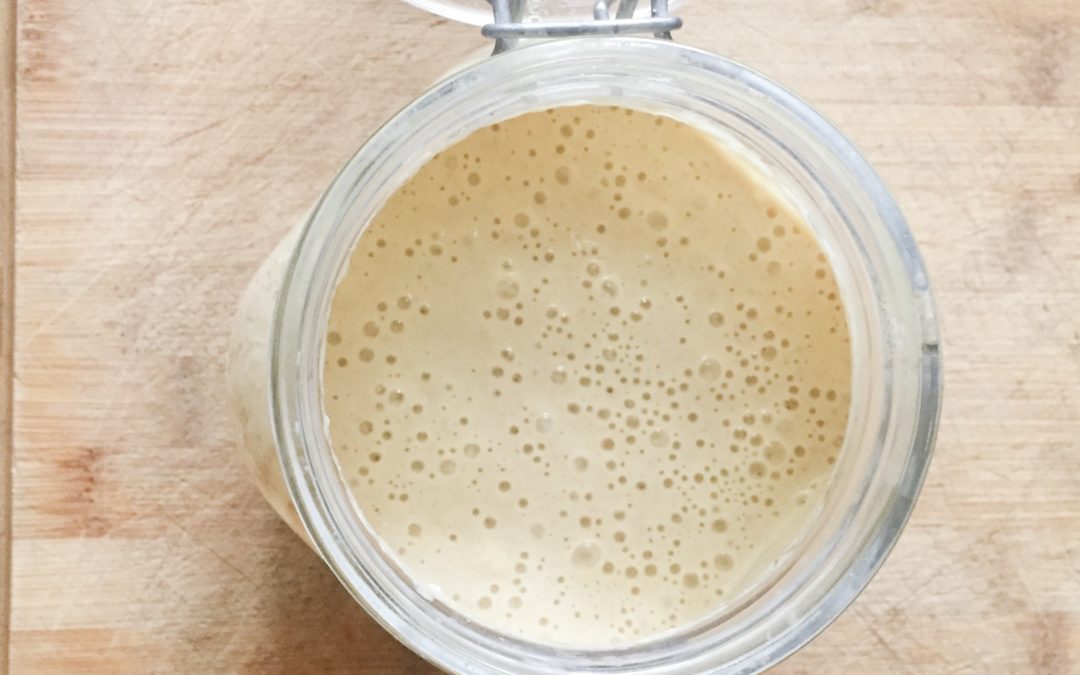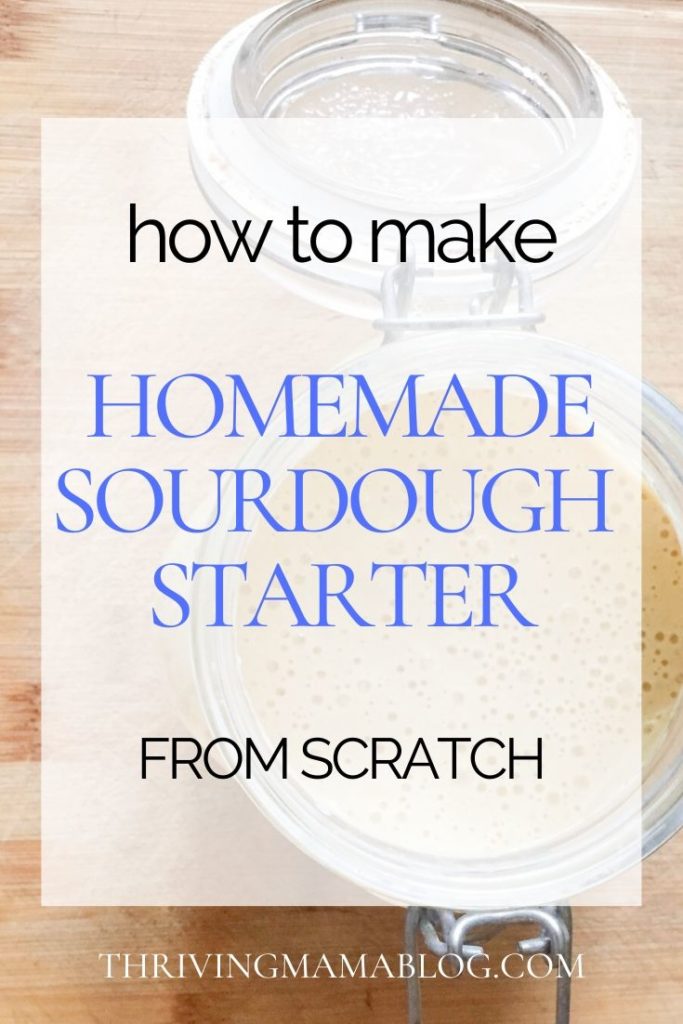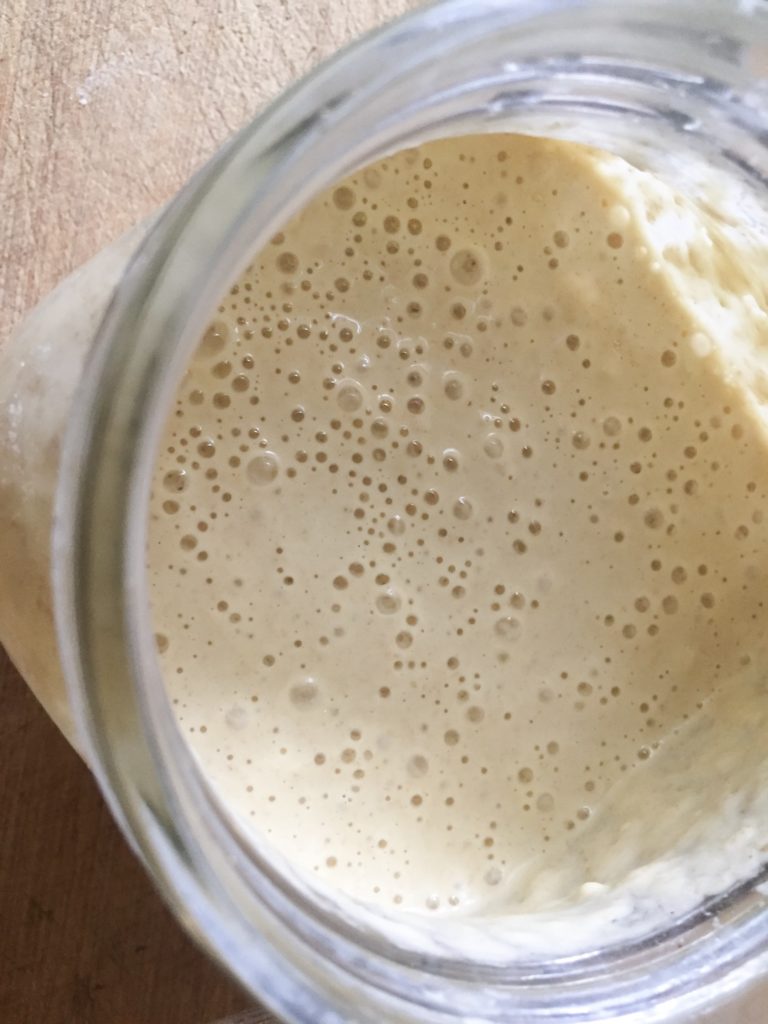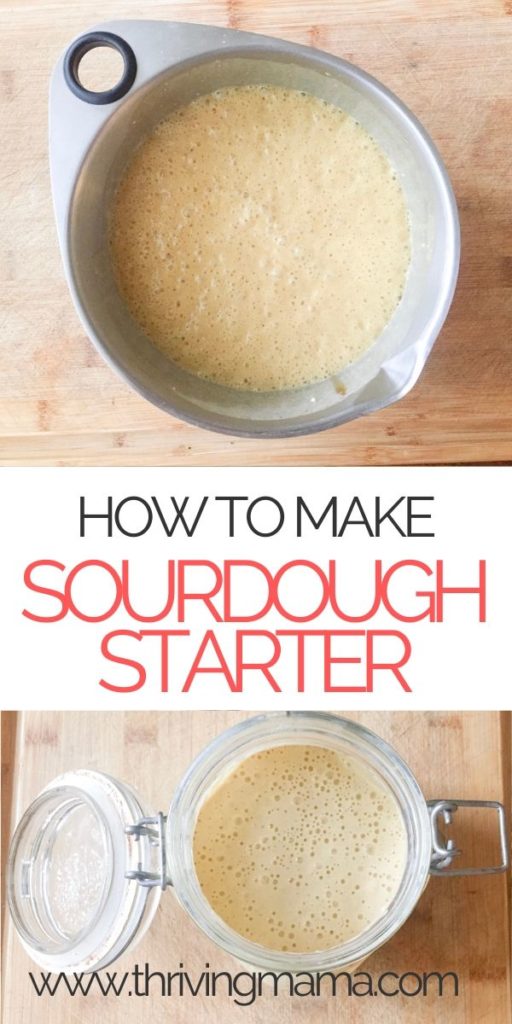Learn how to make an easy homemade sourdough starter from scratch, as well as the health benefits long fermented sourdough can offer.
Making sourdough starter from scratch is a traditional skill that can add so much benefit to your family’s diet.
When I learned that using Einkorn Flour to make long fermented sourdough bread that many people with gluten intolerance are able to enjoy with no issues, I jumped right in!
If you’re needing a good sourdough bread recipe, this is my family’s favorite bread family’s favorite bread
TOOLS TO GET STARTED WITH SOURDOUGH
Before we get started, here are the tools and supplies I recommend:
Good Quality Flour – I prefer Einkorn flour, but any good quality flour will do.
Jars – Don’t get the ones with small openings. I like these jars best. It’s nice to have at least two jars so that you can switch them out every so often while you wash the other one.
Filtered water – I highly recommend the Big Berkey water filter. Actually, I more than recommend it, I ADORE it. It is the best water filter EVER. I love it so much that I wrote an entire post about it. Of course, the Big Berkey is totally optional, but you will want to use a good quality filtered or spring water for your starter.
Cheese Cloth – Cheese cloth like this is best, or at least a clean dish towel.
Also, this book is awesome. If you really want to delve into making GOOD, HEALTHY sourdough, get this book. Especially if you or anyone in your family has gluten sensitivity and you’d like to learn how to make bread that they can eat.
WHAT IS SOURDOUGH STARTER?
If you aren’t familiar with fermented foods and sourdough, let me share with you why someone would go to all the bother of growing a colony of yeast and bacteria in their kitchen.
Back in the “old-fashioned days”, sourdough starter was a valued commodity. This was before yeast was sold in convenient little packets, and so starter was nurtured and passed down through families. The famous San Francisco sourdough starter is one example of this, and there are also many Amish sourdough starter recipes and cultures that have been passed down for generations.
Instead of using instant yeast, people used to leaven bread with a fermented sourdough starter full of beneficial yeasts and bacteria from the environment.
PIN HOW TO MAKE SOURDOUGH STARTER
HEALTH BENEFITS OF SOURDOUGH
Grains (as well as legumes, nuts and seeds) contain an antinutrient called phytic acid. Phytic acid inhibits the absorption of different nutrients. They are beneficial in that they keep the grains from spoiling, but can be difficult to digest.
However, proper preparation of grains will eliminate most of the phytic acid found in these foods.
Proper preparation of foods is an art that has been gradually lost over time. Traditional cultures always soaked and fermented their grains, nuts, seeds and beans. And with the loss of this tradition, we are finding that people can’t handle grains well anymore.
So how do you get a fermented sourdough from scratch started? Read on, and I’ll share my best tips.
HOMEMADE SOURDOUGH STARTER FROM SCRATCH INSTRUCTIONS
This post contains affiliate links, for which we may earn a small commission at no added cost to you. Read our affiliate disclosure here
INGREDIENTS
- Flour (Einkorn, whole grain wheat and unbleached all purpose all work great)
- Filtered water. (I like to use water from my Berkey filter, which you can read more about here)
TOOLS
- Glass bowl or wide mouthed jars (metal and plastic can negatively affect the good bacteria in the starter.)
- Cheese cloth or clean dish towel
DIRECTIONS
- Day 1: Mix one cup of flour of your choice and one cup filtered water. Stir well, making sure all lumps are smoothed out and sides of the bowl are scraped down. Place a clean dish towel over the bowl and set aside. Allow to sit for 24 hours.
- Day 2: Remove half the mixture and discard. Then, add one more cup of flour, one more cup of water, stir well and cover. (The reason you have to remove half of the mixture is that, after a few days you would have more starter than would fit in your bowl. But more importantly, removing half of the mixture makes sure that you have the right amount of flour and water to feed the growing yeast. If you didn’t remove half, you would end up with a lot of starter that wasn’t fully mature.)
- Day 3-5: Repeat the process from day two for days three, four and five.
- Day 6-7: Add flour and water the same as on the other days, but add it every 12 hours instead of every 24.
You will be able to tell if it’s growing and working properly because the starter will begin to bubble and will double in size. By the 7th day, the starter should be mature enough, with enough beneficial yeast and bacteria growing, to make sourdough bread, sourdough pancakes and other yummy things!
SOURDOUGH STARTER MAINTENANCE
Once you get your starter going, there are some things you need to do to maintain your sourdough starter and to keeping it going for continued use.
Feeding sourdough
You will need to feed your starter with more water and flour to make sure the live culture continues to have something to feed off of. Depending on if you refrigerate your starter or keep it out at room temperature will determine how frequently you feed it.
Store in the refrigerator for occasional use
If stored in the refrigerator, you will only need to feed it once every week or even every other week, as the cold slows down the fermentation process.
When keeping your starter in the fridge, you’ll want to pull it out and feed it, then let it set on the counter about 24 hours before you plan on using it.
Store on the counter for daily use
It’s usually best to keep your starter in the refrigerator in between uses unless you are using it daily. If you use your sourdough daily-or almost daily-you may want to leave it out on the counter. If left out, you will need to add water and flour every day. Since the culture is active at room temperature it will ferment much more quickly.
What is the best container to keep sourdough starter in?
Stoneware or glass is the best container for sourdough starter. Plastic or metal can sometimes affect it the cultures. Make sure to keep it loosely covered, either with a lid, plastic wrap or a cloth. If using a lid, be sure not to screw the lid on too tightly as the jar could burst when the starter begins to grow and double in size..
HOW TO USE SOURDOUGH STARTER-MY FAVORITE SOURDOUGH PANCAKE RECIPE
There are so many things you can do with sourdough starter in addition to making delicious bread. English muffins, tortillas, cobblers and rolls…the possibilities are endless. But my current favorite is this recipe for PANCAKES!
SOURDOUGH PANCAKE INGREDIENTS
- 2 cups Sourdough Starter, fed
- 2 eggs
- 1/4 cup butter or coconut oil, melted
- 4 tablespoons sorghum
- 1/2 teaspoon salt
- 1 teaspoon baking soda
- coconut oil or butter for frying
Get my full recipe for Sourdough Pancakes in this post.
CHECK OUT MY OTHER HEALTHY RECIPES:
Gluten Free Vegan Pumpkin Bars + Sweet Potato Frosting
Cranberry Apple Stuffed Acorn Squash Recipe -NO SUGAR
15 Easy Ways to Season Brown Rice
Thanks so much for stopping by! Comment below if you have questions, I’m happy to help!






Hello, I just started my recipe and after 3 days I have a little bit of water on the top of the mixture. Is this ok? Should I start over?
Hi! Yes that’s totally normal! It’s just natural separation. Just stir it well every time you feed it. Let me know how it goes!
Hi! That’s normal, just give it a good stir every time you feed it. Let me know how it goes!
How would I make it gluten free
Hey Erica! It’s not “gluten free” but einkorn flour is an ancient form of wheat that, when fermented, many/most with wheat and gluten sensitivities are able to tolerate with no issues.